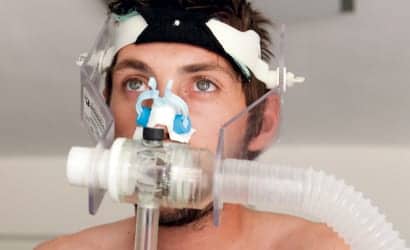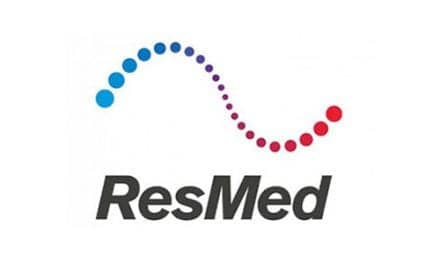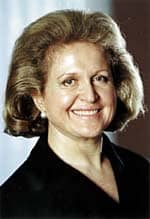While pulmonary rehabilitation programs are an important part of a treatment plan for those with chronically impaired lung function, their value in treating a wide range of postsurgical patients at risk for developing pneumonia and other respiratory conditions is becoming recognized.
By Phyllis Hanlon
Formal pulmonary rehabilitation programs have been in existence since the mid-1990s, but a rudimentary form was used to treat tuberculosis as far back as the 1880s. Over the years, diagnostic tools and intervention methods have been refined and the therapy has expanded its use to a wide range of respiratory conditions from chronic obstructive pulmonary disease (COPD) to cystic fibrosis (CF) and many others in between. And more recently, protocols have been developed that address postoperative care for general and vascular surgery.
Standard Programs
For the most part, traditional pulmonary rehab programs serve the same patient population and follow a similar treatment protocol. Staffing for pulmonary reha
b programs varies according to need, but many comprise, at the minimum, a nurse, physical therapist, occupational therapist, exercise physiologist, and respiratory therapist. When needed, specialists are often available for consultation. Richard Novitch, MD, pulmonary rehabilitation director and director of the pulmonary function laboratory and blood gas laboratory at Burke Rehabilitation Hospital in White Plains, NY, explained that the treatment is directed toward patients suffering from a reduction in quality of life due to COPD or other lung diseases. “It’s a way to help people develop coping strategies with the limitations of life activities,” he said. “Regardless of age and underlying diagnosis, the quality of life issues are the same.”
Shortness of breath often prompts a referral from a pulmonologist, internist, or primary care physician. Patients sometimes ask to self-enroll; however, in order to comply with Medicare guidelines, which drive pulmonary rehab protocols, the patient must have a physician referral. Medicare Part B may cover the cost of pulmonary rehabilitation if certain conditions are met. The patient must have a diagnosis of moderate to very severe COPD (validated by pulmonary function tests), and must be documented to meet Medicare’s GOLD Classification II, III, or IV. Additionally, Medicare requires all pulmonary rehab programs to include physician-prescribed exercise, education, and training customized to each patient, along with psychosocial and outcome assessments. Moreover, the exercise plan must designate mode, target intensity, duration of each session, and frequency. The physician also must review the treatment plan every 30 days. A total of 36 visits are allowed with an additional 36 upon receipt of a letter recommending more rehabilitation. Other insurers may cover pulmonary rehab, and many often follow Medicare’s protocol requirements.
Risks in pulmonary rehab programs are virtually nonexistent, said Novitch. “Patients exercise to tolerance of risk. The lungs act as a governor on an engine. If the patients are sick, they don’t show up. Also, Medicare guidelines require a doctor to be within walking distance—300 feet—of a program,” Novitch noted, adding that other clinical professionals are in attendance at all times.
Clinics or hospitals seeking to create pulmonary rehab programs should have a dedicated time and place to work with patients. “Start simple and go from there. It’s not rocket science,” Novitch pointed out. Support from administration as well as participation from a respiratory care decision maker and other clinical staff are necessary. Burke’s program operates on a part-time basis with two groups twice a week for an hour each session.
Novitch pointed out that, while a pulmonary rehab program is relatively simple to launch and operate, compensation is minimal. Providers receive $36 per visit (the standard fee established by Medicare) for pulmonary patients, versus $60 for patients in cardiac rehab programs, he explained.
In spite of funding issues, Novitch said, “Every hospital should be doing some sort of rehabilitation. It’s a community service and not a moneymaker, but it will become a standard of care. Having such a program could also become a point of differentiation between your institution and another.”
Diagnostic and Treatment Tools
Prior to entering a program, a patient’s qualification must be verified using a spirogram—a tracing or graphic of respiratory movements. “Aside from a physician referral, we can’t guess that they have COPD. They have to be evaluated so we have an intellectual framework,” Novitch pointed out. Spirometry, as well as a number of other monitoring tools, helps to steer the therapy to ensure maximum results and optimal patient health, he added.
Exercise, for example, serves as the cornerstone of many pulmonary rehab programs, and demands that patients work out hard enough to make progress but not so hard they exacerbate their breathing conditions. During each session, therapists use pulse oximeters to monitor changes in oxygenation, which may prompt modifications to the exercise regimen.
Chest physiotherapy, including mechanical mucus expulsion and coughing techniques, is also part of some rehab programs. Mucus clearance devices help to maintain clear airways, allowing the patient to get maximal benefit from other aspects of the program. Burke Rehabilitation Hospital uses the acapella Vibratory Positive-Expiratory Pressure (PEP) Therapy System by Smiths Medical, but several different devices are available. A 2008 study by Hristara et al found that mucus clearing devices appear to increase patient compliance with daily treatment due to ease of use and effectiveness in improving pulmonary function.1 These airway clearance devices range from positive expiratory pressure to high frequency chest wall oscillation, oral high frequency oscillation, and intrapulmonary percussive ventilation to incentive spirometry.
Depression
Clinicians have found depression to be common in patients with lung conditions. “At Burke, we’ve been doing research for 12 years in collaboration with the Institute for Geriatric Psychiatry at Cornell,” said Novitch. “One-quarter of the patients we see have depression. We make sure the patient is treated and look at psychotherapeutic interventions.” He cited cognitive behavioral therapy (CBT) as one of the proven techniques to reduce depression and motivate patient compliance with rehab therapy.
Novitch coauthored a study published in 2006 that reported approximately 30% of patients with COPD experience depression; the study evaluated whether behavioral interventions during pulmonary rehabilitation could reduce symptoms. Findings showed that half of patients showed a 50% or greater reduction in depressive symptoms from baseline.2 “The problem with behavior associated with lung disease is that we are trying to find the root of the problem looking across a spectrum,” Novitch explained. “Personal intervention for behavioral issues in COPD is the key to training people to be more proactive. A lot of rehab programs have a ‘one and done’ mentality. COPD spans a continuum of care, including inpatient and outpatient, support, and a maintenance program. Training might be a good adjunct to get the patient to pursue exercise regularly.”
Socialization
Henry Ford Hospital in Detroit launched its pulmonary rehabilitation program in 1996. Cheryl Szymanski, RN, nurse leader of the department, explained that the program works with approximately 70 patients annually who have lung disease and related disorders, such as COPD, pulmonary fibrosis, cystic fibrosis, and pulmonary hypertension, as well as sarcoidosis candidates.
After a thorough screening process in which Szymanski reviews patients’ symptoms, medical history, medications, and cause of shortness of breath, she has a good idea of the most appropriate regimen for the patient. “During orientation, we talk about the program, the equipment patients will use, what they can expect, and their responsibilities,” she said. “I have a PowerPoint presentation I show for the educational piece. We talk about lung disease, better breathing techniques, conserving energy, stress management, respiratory infection, and nutrition. I also have a tape I use for relaxation.” Handouts, DVDs, brochures, and conversation among the patients further help to disseminate necessary information.
Henry Ford’s program takes place in a fitness center so staff and patients have access to several different types of equipment, including a treadmill, recumbent stepper, ergometer, and machines for strengthening hips, thighs, and core. “We have the patient use a step to simulate stair climbing. They also have the option to use a balance ball for warm-up and stretches,” Szymanski said.
From the day patients start the program, Szymanski encourages them to set goals to find the best way to get and remain healthy. “The patient in pulmonary rehab aims to reduce shortness of breath with activity. Once they do, they can do more, walk better, or go back to driving. People who don’t come can have difficulty breathing. At home, they may not have an idea of how to manage their symptoms,” she said but acknowledged that humidity and weather changes affect breathing and sometimes prevent patients from engaging in exercise routines.
While the formal aspect of the program is critical to improved quality of life, patients gain as much, if not more, from socializing with others in similar situations, according to Szymanski. “They learn from each other, share symptoms and concerns. They make good friendships and look forward to coming to the program,” she said. This environment helps patients maintain their participation and become proactive about their health.
Comorbid Illnesses
The 28-year-old pulmonary rehab program at Bryn Mawr Hospital in Philadelphia treats elderly patients with lung problems and other medical diagnoses, such as heart disease or musculoskeletal problems, according to Roland Lindsay, BS, RRT, RPFT. “Far and away, the majority of patients have COPD and pulmonary fibrosis. But we are seeing a few more patients before and after procedures like lung volume reduction surgery to implant devices related to the RENEW study,” he said.
Based on its patient population, Bryn Mawr prefers to work with small groups so patients can receive one-on-one attention. In this setting, providers are more apt to detect issues such as pain. For instance, patients who experience pain from spinal stenosis or knee or hip arthritis receive referrals to a pain clinic or specialist who can help manage the discomfort. “Exercise won’t further damage the patient. We push them as far as we can while reassuring them that pain doesn’t mean the problem is getting worse,” Lindsay said.
When patients present with COPD as well as another physical and/or psychological issue, they receive appropriate referrals. “If someone is obese, they may need nutritional therapy. If there’s a psychosocial disturbance, we refer them to a psychologist or psychiatrist,” he said. “Most of our patients have some degree of depression. They may be grieving over the lack of lung function or they may have anxiety, which can be caused by shortness of breath.”
These comorbid illnesses, along with associated medications, can impact motivation, according to Lindsay. “We need to find out why they came. Usually patients have some goal in mind.” He mentioned one woman who required the use of continual oxygen. She did not want to attend her son’s upcoming wedding wearing a nasal cannula and carrying an oxygen tank. “She is anxious, but determined to be functional in a social setting,” Lindsay said. “All patients should have a strong motivator like that.”
Educational components typically address the same issues, but at Bryn Mawr patients also learn about traveling with chronic lung disease, or any chronic condition for that matter. “Most important, we also teach patients how to slow down their breathing. These patients are used to doing what they want. They are mentally in a hurry,” Lindsay said.
Lindsay has worked in pulmonary rehabilitation for 20 years and firmly believes in the value of the program, but would like to see patients referred sooner. “People come to us when there’s not much else you can do. It’s easier to get a patient on a wellness path if he’s younger and fitter. If physicians referred when shortness of breath first presented, it would be much better. Once comorbidities accumulate, it’s a lot harder,” Lindsay emphasized.
Postsurgical Rehab
Although pulmonary rehabilitation is traditionally used for those with lung conditions, it can also be effectively applied to treat other patients. At Boston Medical Center (BMC), David McAneny, MD, division chief of general surgery, chief of the section of surgical oncology, and vice chair in the Department of Surgery, and Pamela Rosenkranz, RN, BSN, MEd, director of clinical quality and patient safety in the Department of Surgery, noted that the incidence of postoperative pneumonia and unplanned intubation at BMC was 2.6% (1,569 patients) and 2.0% (1,206 patients), respectively. The cost of respiratory complications for a single institution runs approximately $52,466 per patient and increases the length of stay to 14 days,3 according to a 2004 data analysis from the National Surgical Quality Improvement Program (NSQIP).
In an effort to reduce those costs and increase patient safety and well-being, McAneny and Rosenkranz cocreated I COUGH,4 “a suite of interventions for reducing postoperative pulmonary complications.” This program was implemented for all general and vascular surgery patients at BMC in August 2010. McAneny called it a “fairly simple program” that covers six key components:
Incentive spirometry;
Coughing and deep breathing;
Oral care (brushing teeth and using mouthwash);
Understanding (patient and family education);
Getting out of bed at least three times daily; and
Head-of-bed elevation.
Rosenkranz added that pain control is also an important component of the program. “A nurse works with the patient to help patients understand that pain control options are available,” she said, explaining that patient-specific, patient-controlled narcotic and non-narcotic agents are used. McAneny said, “We strive to use non-narcotic analgesics. Anecdotally, I am impressed by how comfortable patients are. There is an amazing difference with the reduction of narcotic use.”
Like most other programs, I COUGH incorporates an educational component for patients and families that takes place before and after surgery. “Prospectively, we make personal contact so there’s not as much angst about rehab following surgery,” McAneny said. Preformatted informational brochures, videos, and posters inform the patient about the importance of postoperative pulmonary care. Based on the ethnic diversity of the patients that BMC serves, the I COUGH videos and brochures used to educate patients and families are translated into Spanish, Portuguese, Haitian Creole, and Vietnamese, according to Rosenkranz. The information in the materials is reinforced by patient interactions with hospital staff. For instance, prior to surgery, nurses will show the patient how to use a spirometer and then have him practice. “The nurse records the pre-op target and then can compare this with the post-op measure,” said McAneny.
McAneny created standardized electronic physician orders for I COUGH so that healthcare professionals who work in different units will be familiar with the protocol and execute it appropriately. “We’re trying to establish a standard of care for all patients,” he said.
Making an Impact
After implementing I COUGH, Boston Medical Center saw some dramatic results for the hospital’s 250 rehab patients. Prior to the program, at the time of a nursing visit, only 19.6% of patients were found out of bed (in a chair or walking) while 80.4% were in bed. In addition, 82.7% had the head of the bed elevated and 52.8% had a spirometer within reach. However, post-I COUGH implementation results found that 69.1% of patients were out of bed at the time of a nursing visit, 91.5% had the head of the bed elevated, and 77.2% had a spirometer within reach.
Creating good habits helps to reinforce the interventions, so McAneny and his team at BMC make suggestions that trigger the patients to take action: when each meal tray arrives, he recommends the patient should get out of bed; when they are watching TV, each time a television commercial break appears, he advises the patient to use their spirometer. “We’re trying to establish a routine,” McAneny said. “We have a level of expectation. We give [patients] a concrete notion of what we want them to do, but they become the drivers of the program.” RT
Phyllis Hanlon is a contributing writer for RT Magazine. For further information, contact [email protected].
References
- Hristara-Papadopoulu A, Tsanakas J, Diomou G, Papadopoulu O. Current devices of respiratory physiotherapy. Hippokratia, 2008, Oct-Dec; 12(4):211-220. http://www.ncbi.nim.nih.gov/pmc/articles/PMC2580042/pdf/hippokratia-12-211.pdf
- Alexopoulos GS, Sirey JA, Raue P, Kanellopoulos D, Clark TE, Novitch RS. Outcomes of depressed patients undergoing inpatient pulmonary rehabilitation. Am J Geriat Psychiat, May 2006; Vol. 14(5):466-475.
- Dimick JB, Chen SL, Taheri PA, Henderson WG, Khuri SF, Campbell DA Jr. Hospital costs associated with surgical complications: a report from the private-sector National Surgical Quality Improvement Program. J Am Coll Surg. 2004; 199(4):531-537.
- Cassidy MR, Rosenkranz P, McCabe K, Rosen J, McAneny D. I COUGH: Reducing postoperative pulmonary complications with a multidisciplinary patient care program. JAMA Surg. 2013;148(8):740-745.












